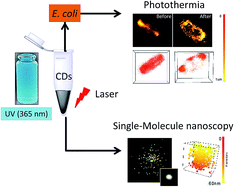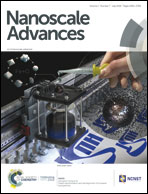Carbon dots, a powerful non-toxic support for bioimaging by fluorescence nanoscopy and eradication of bacteria by photothermia†
Abstract
Carbon Dots (CDs) are innovative materials which have potential applications in many fields, including nanomedicine, energy and catalysis. Here CDs were produced by the alkali-assisted ultrasonic route and characterized by several techniques to determine their composition and properties. Fluorescence nanoscopy using single-molecule localization microscopy shows that they have very good photophysical properties and a remarkable blinking behaviour at 405 nm. Moreover, these CDs are a safe material, non-toxic towards different cell lines (cancer and non-cancer cells) even at very high concentration, reflecting an excellent biocompatibility. Photothermia, i.e. their heating capacity under laser irradiation, was evaluated at two wavelengths and at several power densities. The resulting temperature increment was high (5 < ΔT < 45 °C) and appropriate for biomedical applications. Bioimaging and photothermia were then performed on E. coli, a Gram(−) bacterium, incubated with CDs. Remarkably, by photothermia at 680 nm (0.3, 1 and 1.9 W cm−2) or 808 nm (1.9 W cm−2), CDs are able to eradicate bacteria in their exponential and stationary phases. Images obtained by 3D super-resolution microscopy clearly show the different CD distributions in surviving bacteria after mild photothermal treatment. These results confirm that CDs are multifunctional materials with a wide range of biomedical applications.

- This article is part of the themed collection: Nanocarbons


 Please wait while we load your content...
Please wait while we load your content...